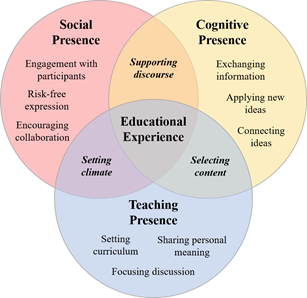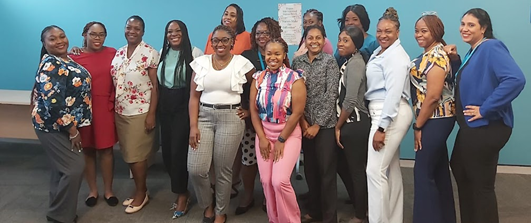This is my final academic blog
post….so I thought I would do it as a personal reflection.
As a so-called “adult- learner”,
diving into this degree program has been like trying to ride a unicycle while
juggling flaming torches - a real adventure!
I've had to wrap my head around new
content and jump back into the world of nursing after a solid decade away from
the profession. To add to this, everything was strictly online, which was about as
familiar to me as speaking Chinese.
But - the Community of Inquiry
framework (COI), this well-designed tool, has been my course facilitator's trusty
sidekick, helping me navigate these uncharted academic waters.
 The Community of Inquiry (COI) a
theoretical framework and a pedagogical model that represents a process of
creating a deep and meaningful learning experience through the development of
three interdependent elements: social, cognitive, and teaching presence1. It is
designed to offer adaptable, supportive, collaborative, and engaging ways of
learning through both process and content, fostering a sense of community and
belonging within the course.
The Community of Inquiry (COI) a
theoretical framework and a pedagogical model that represents a process of
creating a deep and meaningful learning experience through the development of
three interdependent elements: social, cognitive, and teaching presence1. It is
designed to offer adaptable, supportive, collaborative, and engaging ways of
learning through both process and content, fostering a sense of community and
belonging within the course.Reflecting on Zoom's capabilities, which enhance teacher presence, I am struck by how it bridges the gap between instructors and myself, creating a sense of immediacy and engagement that can sometimes be difficult to achieve in virtual environments. Features like video conferencing and breakout rooms truly enable educators to recreate the interactive and dynamic learning experiences of traditional classrooms. The ability to present complex concepts visually through screen sharing makes abstract ideas more tangible, enriching the learning process for students.
To make it sweet, you're sitting in your pajamas. OH and thank
goodness for recording sessions, right? They're a lifesaver for me with a busy
schedule. I mean, who wouldn't want the freedom to hit the replay button on a
lecture? It's like having your own personal time-turner from Harry Potter!
I find great enjoyment in journaling
(in my book). However, I admit to feeling uneasy about blogging, as it exposes
my innermost thoughts to a wide audience. Nevertheless, I recognize that
Blogger offers an exceptional platform for Social
Presence, allowing students to share their personal reflections and
experiences in an interactive manner. The platform facilitates the development
of a sense of community, purposeful communication, and the nurturing of
interpersonal relationships.
PAUSE and follow my page
During the last semester, while I was busy discovering just how many ways things could go wrong, I found my lifeline in the form of WhatsApp and our trusty group chats. Amid the chaos, my dear batchmates Jaime, Susma, Rose, Herberlena, Patrice, and Kathleen emerged as my partners in academic survival. It turns out that their support, combined with our shared expectations and communication, played a pivotal role in my growth as a student. Who knew that group chats could be the secret weapon in navigating the treacherous waters of academia? Hence, this is another platform educators can utilize to have accessibility to students and vice versa.
DROPPING THIS PHOTO OF THE AWESOME GROUP
The final element within the COI
is cognitive presence; this element
enabled me to interact in a meaningful way with the content being taught and to
apply this meaning to create connections and to seek real-world applicability
of the content that I was learning. As a novice entering the education arena,
I learned about Screencast-O-Matic, which can be used to facilitate cognitive
presence and assist instructors in creating detailed, visual explanations of
complex concepts. Through screen recordings paired with voiceovers, educators
can guide students step-by-step through intricate processes, breaking down
barriers to understanding.
I was tasked with doing this as an
assignment. In my true Bradshaw sense, I think I made the topic of HIV, which
is usually daunting, engaging, and, in my opinion, enables understanding to my
audience. FUN FACT a screencast can be also uploaded on YOUTUBE
Check Mines
I truly enjoyed the course Instructional
Application of Technology it has become evident that how various technology
tools, such as Zoom for real-time interaction, Screencast-O-Matic for
asynchronous content delivery, Blogger for reflective journaling, and YouTube
for accessible multimedia resources, can be strategically integrated into
online courses. This integration has the potential to enhance each element of
the CoI framework, thereby enriching the overall learning experience for both learners
and educators alike.






.jpg)


